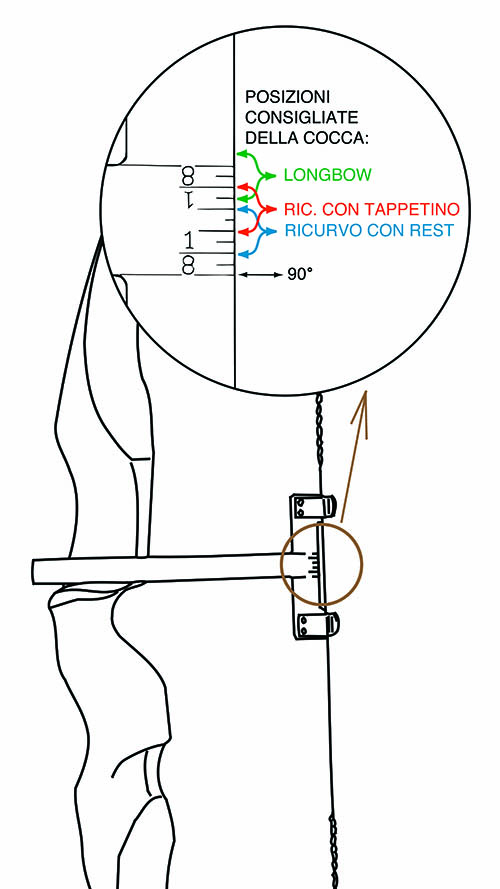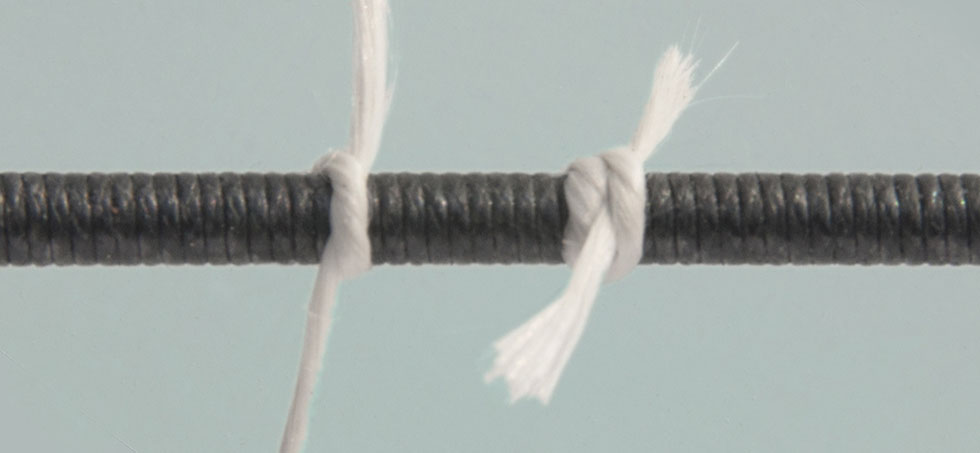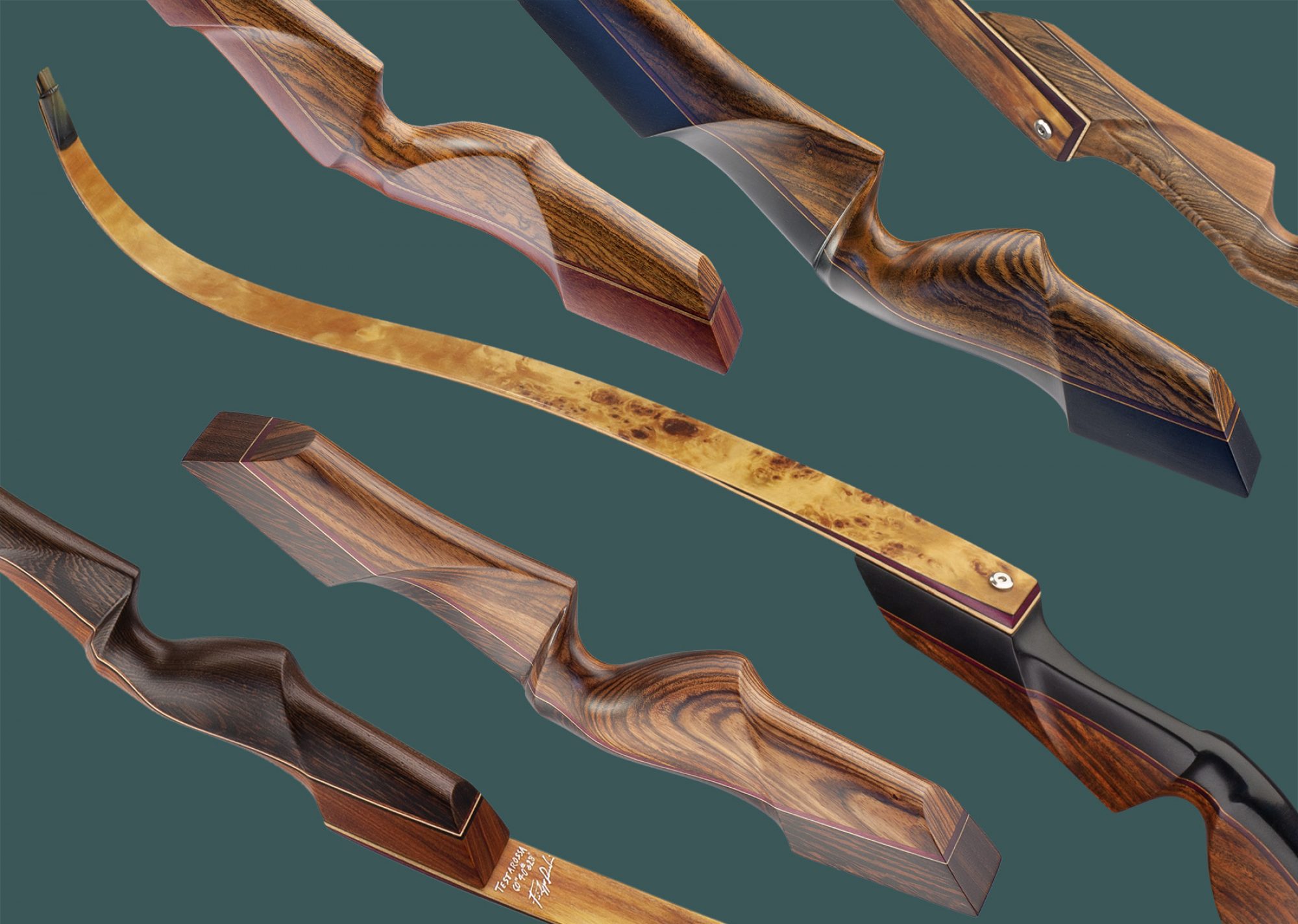The bow string is very important element for any bow: It must be as light and less elastic as possible to transfer more energy to the arrow. The companies that produce them have been chasing the myth of the totally “inextensible” rope for decades and have been using DYNEEMA as the best material available in the last years.
Of course, such a string provides great advantages in terms of arrow speed but requires the bow to be built specifically to bear it. Non-specially structured bows could break very easily. For this reason, on any bow of old construction or not specially guaranteed, strings are used in the common and most elastic DACRON material.
The Picchio Testarossa is guaranteed for the use of any string and is equipped with Dyneema 8125 strings, with the minimum number of strands and the length of the central serving reduced to the necessary to weigh as little as possible.
The FLEMISH type strings, even if more aesthetically beautiful, require several turns of twisting which make them slightly more elastic and compromise their efficiency. The ideal number of twisting turns for the string should be between 10 and 30. Without twisting the string risks being less aerodynamic and with too many it risks becoming elastic. It is very important that the twisting turns are given in the right direction according to the spirals of the serving which can be observed very closely. In the right direction, the spirals of the serving must tighten while on the contrary the serving loosens and risks moving or opening soon.
The string must be regularly waxed and checked in its integrity. Mounting a damaged string could be very dangerous and breaking it can cause damage to the archer and bow. Especially the area of the loops (the rings that slip on the tips) is subject to very high stresses.

An early wear of the serving that protects it in this area could indicate that the area of the tips in contact with the string has some anomaly in the paint and is wearing it excessively. In this case it is necessary to re-polish and, if necessary, spread new paint on this area which is subject to particularly high pressure.
The distance of the string from the bow is called BRACE HEIGHT and affects the functioning of the bow (not that much…). Changing it does not involve any risk and therefore we can safely do some tests. To modify this distance, the string must be twisted or untwisted to modify its length by a few millimeters; if necessary, you have to switch to a rope of a different length. It must be borne in mind that a shorter distance (longer rope) improves speed performance but worsens stability and vice versa. If we look at the bows built 50 years ago, they hardly worked well with a Brace of less than 10 inches. Recently the technological improvement makes it possible to use much shorter braces. I personally think a good bow should work fine with a shorter brace high.
.
.
The measurement is made from the notch of the grip (the Pivot Point) and inches are used. For the Picchio Testarossa I recommend 6.9-7.1 for the 430 riser and 7.2-7.5 for the 500 riser but, as I said, there are no risks if you want to experiment with different ones. Of course, if to reach the desired distance it is necessary to give too many or too few twists, it would be better to switch to a different size string.
About measurements, it’s worth explaining how string measurement works. As you know, in our sport the Anglo-Saxon system of measures (inches, pounds, etc.) also called Imperial is used, which various “oddities”. Aside from the use of thumbs, it might seem sensible to simply measure the length of the string to name it and then a 60 “string might be thought to be 60 inches long, but not.
By 60 “string we mean a string suitable for a 60 inch bow and, of course, is have to be shorter. But how do you measure a bow? For the length of the string once loaded you will think … But no. It is measured by running its side towards the target and following its curves, so two 60-inch bows may need very different strings and you never know which string is right for your bow.

About the Testarossa Bow, these are the correct sizes:
58″=1390mm,
60″=1450mm,
62″=1490mm,
64″=1545mm.
As for the NOCKING POINT, it is necessary that it is in the right place, that it does not move and that it is as small and light as possible.
I ABSOLUTELY do not recommend metal ones. A good way to do this is to use NON-waxed Dacron thread, wet the serving area with glue and proceed by making a simple knot, then pull very hard to tighten it, and tie another one on the opposite side and again one on the first side.
Do not double in a knot so as not to create an external “dot” that would be annoying. still pull very hard to tighten the knots.
Cut the threads with a very sharp scissors, so as not to move the knots, leaving a “fuse” of about 5mm. Set the fuses on fire by locking the loose yarn around the knots.

Per ulteriori informazioni sulle corde QUESTA è una pagina molto interessante di Riccardo Franzi e troverete molte altre cose interessanti sul suo blog.


